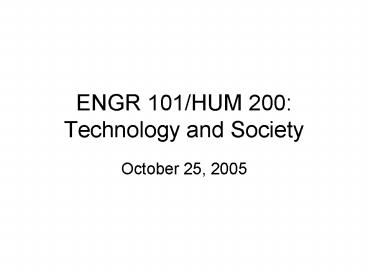ENGR 101/HUM 200: Technology and Society - PowerPoint PPT Presentation
1 / 25
Title:
ENGR 101/HUM 200: Technology and Society
Description:
Electric vs. gas light. New product must cost less. Enabling technology ... Automobile manufacturers looking for good fuel match for fuel cell technology ... – PowerPoint PPT presentation
Number of Views:33
Avg rating:3.0/5.0
Title: ENGR 101/HUM 200: Technology and Society
1
ENGR 101/HUM 200 Technology and Society
- October 25, 2005
2
Agenda
- The Hydrogen Economy
- Innovative Designs (video segment)
- Hand back exams
3
Hydrogen Fuel v. Hydrogen Economy
- Changes in energy sources have broad economic
consequences - Energy is a key input into our economy
- The current worldwide economy is dominated by
fossil fuels - Energy fuels economic growth
- Infrastructure is shaped by energy needs
- Energy is infrastructure
4
Replace or Enable?
- Replacement technology
- Replaces an existing product
- Electric vs. gas light
- New product must cost less
- Enabling technology
- Provides a new capability
- Airplanes and flight
- Cost not as important
- Consider the technology for Make it Better
5
Fuel Cells Replace and Enable
- Energy efficiency is about replacing a technology
- Providing environmental protections (whether or
not in response to regulations) is about enabling
a technology
6
Hydrogen Replaces and Enables
- If it increases efficiency of ICEs, that is
replacement - If it creates a decentralized energy
infrastructure, that is enabling
7
Hydrogen Economy
- Network of three functional steps
- Production
- Storage
- Use
- But where does hydrogen come from?
- Lots of it, but not in the right form for use as
a fuel - Not just a fuel, but an infrastructure
8
Challenges Posed by H.E.
- Competitive production
- Distribution
- Storage
- Safety
9
Why Hydrogen?
- Need replacement for fossil fuels
- Energy independence, pricing, worldwide stores
- Environmental regulations (Clean Air Act, CAs
zero emission standards) - Hydrogen is viewed as clean, renewable energy
source - Hydrogen is also an energy carrier for renewable
energy sources (stores, moves, and delivers
energy in a usable form to consumers)
10
Some economic drivers
- Automobile manufacturers looking for good fuel
match for fuel cell technology - Governor of California initiated Hydrogen Highway
Project - 150-200 stations along state highways
- 500K each
- One step in chicken-egg dilemma
11
Where does hydrogen come from?
- Introduction of hydrogen as an energy source for
fuel cells doesnt necessarily mean no use of
fossil fuels - Hydrogen is produced from
- natural gas, coal, gasoline, methanol, or biomass
through the application of heat (reforming) - from bacteria or algae through photosynthesis
- using electricity or sunlight to split water
into hydrogen and oxygen.
12
Fossil Fuels
- Not renewable
- Reserves will eventually run out
- Some debate on when modes of extraction becoming
more complex, more expensive - Prices are rising even now
- By 2050, there will be a 50 increase in energy
use worldwide - Population growth
- Industrialization of developing countries
13
Current Energy Sources
- Oil supplies 40 of the worlds energy needs
- Oil accounts for 90 of energy used for
transportation - Cars trucks produce 10 of carbon dioxide
emissions in the US - Power plants produce more than 40 of carbon
dioxide in US
14
Fuel Cells and Hydrogen
- Hydrogen fuel should not be confused with fuel
cell technology - In order to use hydrogen as a fuel, it still
needs to be liberated from somewhere, and that
takes energy - Hydrogen fuel can be used to power ICEs as well
as fuel cells - Fuel cells are more efficient than either ICEs or
batteries (can be constantly replenished open v
closed system) - ICE standards of longevity 15 years or 170K
miles - Current PEM (proton exchange membrane) fuel
cells 2000 hours
15
Fuel Cells in development
- Fuel cells as batteries for consumer electronics
- Canons announcement 10/25 that it has developed
fuel cells to replace conventional batteries for
digital cameras and printers in 3 years - Have to find way to provide consumers with fuel
16
(No Transcript)
17
(No Transcript)
18
(No Transcript)
19
(No Transcript)
20
(No Transcript)
21
Some work being done at UW
- http//depts.washington.edu/fuelcell/Info/FAQ/FAQ.
htm - http//faculty.washington.edu/stuve/uwess/uwess.ht
m - http//faculty.washington.edu/cooperjs/Definitions
/design_for_environment.htm - http//faculty.washington.edu/cooperjs/Definitions
/life_cycle_assessment.htm - Life cycle assessment is a protocol to assess
the environmental, economic, and social impacts
of an industrial system
22
What Interrupts the Optimistic Narrative?
- Hydrogen fuel burns clean but hydrogen fuel
production is dirty - Hydrogen is not an energy source like oil, coal,
wind or sun but an energy carrier like
electricity or gasoline - But, the only byproduct from burning hydrogen in
an ICE or a fuel cell is water
23
Likely Early Adopter Industries
- For hydrogen as a fuel
- Not cars
- Difficulty manufacturing in advance of sufficient
consumer demand - Fuel companies unlikely to invest in
infrastructure (filling stations) till a critical
mass of cars - For fuel cells
- Battery replacements
- Infrastructure elements that are looking for
decentralization
24
Some Public Policy Issues
- Infrastructure for developing countries
- A hydrogen economy would democratize energy
generation so that all nations can have equal
access to the benefits of electricity. The
Futurist - Values
- Shift required for an energy policy that promotes
energy independence based on diverse sources of
cleaner energy, combined with tough emission
standards, and conservation effort - Safety
- Hindenberg misconception hydrogen fires not
easily detectable (odorless, colorless gas)
25
Next class
- Guest lecture Prof John Kramlich
- Read The Diamond Age































